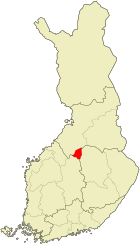Pyhäjärvi (city)
| coat of arms | map |
|---|---|

|

|
| Basic data | |
| State : |
|
| Landscape : | Northern Ostrobothnia |
| Administrative community : | Nivala-Haapajärvi |
| Geographical location | 63 ° 40 ′ N , 25 ° 53 ′ E |
| Surface: | 1,459.60 km² |
| of which land area: | 1,311.25 km² |
| of which inland waterways: | 148.35 km² |
| Residents : | 5,248 (Dec. 31, 2018) |
| Population density : | 4 people / km² |
| Municipality number : | 626 |
| Language (s) : | Finnish |
| Website : | www.pyhajarvi.fi |
Pyhäjärvi [ ˈpyhæjærvi ] is a town with 5248 inhabitants (as of December 31, 2018) in Finland. It is located around 170 km away halfway between the cities of Oulu and Jyväskylä in the northern Ostrobothnian landscape .
The municipality of Pyhäjärvi has existed since 1866. In 1993 it was granted city rights, and on this occasion it briefly changed its name to Pyhäsalmi , but reversed this in 1996. The parish church village is located on the north shore of the eponymous lake Pyhäjärvi , which covers an area of around 125 km² and is divided by numerous bays, peninsulas and lakes. Other settlements are Hiidenkylä, Jokikylä, Kirkonkylä, Kuusenmäki, Lamminaho, Liittoperä, Parkkima, Rannankylä, Ruotanen, Salmenkylä, Haapamäki, Vuohtomäki, Lohvanperä, Pitäjänmäki and Latvanen.
The main industry in Pyhäjärvi is mining. The copper and zinc ore mine operated by the Canadian Inmet Mining Corporation has now been driven about one and a half kilometers into the depth; thus the Pyhäsalmi mine is one of the deepest ore mines in Europe.
In Finland, Pyhäjärvi is still known for the annual Täydenkuun Tanssit (“full moon dance ”) dance festival held in late summer .
Individual evidence
- ↑ Maanmittauslaitos (Finnish land surveying office): Suomen pinta-alat kunnittain January 1, 2010 . (PDF file; 194 kB)
- ↑ Statistical Office Finland: Table 11ra - Key figures on population by region, 1990-2018